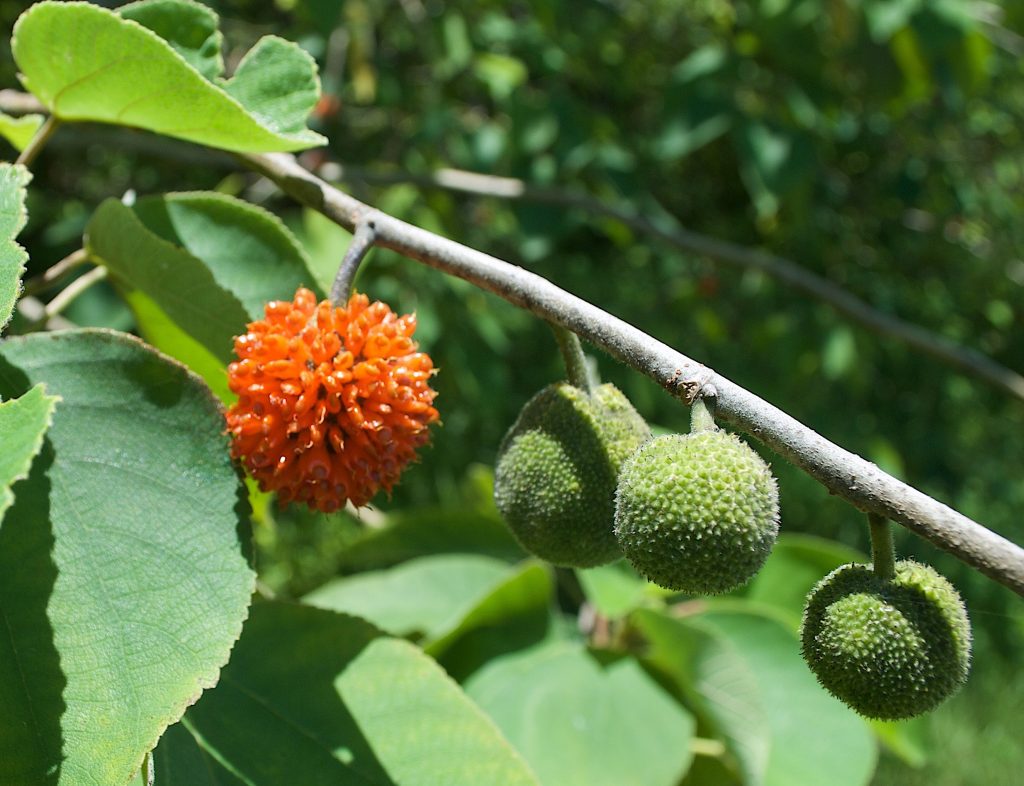
Paper Mulberries are related to bread fruit. Photo by Green Deane
On the coast of Maine about seven miles south of Portland is the Town of Scarbrough. There you will find Pine Point and Black Point. They are separated by the Nonesuch River which empties into Casco Bay. These points are less than a thousand feet apart as the seagull flies. Pines predominant on southern Pine Point and the darker-colored spruce on the northern Black Point. Why? Soil? Human intervention? No. A significant ocean current turns at those points making Black Point slightly cooler annually — attractive to spruces — and Pine Point slightly warmer making it more attractive to pines.
Distance and or elevation can significantly affect plant selection and growth. Here in flat-iron Florida a 76-mile separation decides whether our Paper Mulberries pictured above and right, will have fruit or not. In the northern areas of the state the tree puts on fruit. In the central part of the state it rarely fruits because the winters are too warm. However after our record-cold winter this year they are fruiting. The Paper Mulberry is from a temperate climate and prefers cooler temperatures. This past weekend in Jacksonville — 136 miles to the north — the trees were full of orange pom-pom like fruit. The orange part is edible but not the lump in the middle. Paper Mulberries can also sneakily reproduce vegetatively, something the importers had not planned on.
Environmental preferences can also be seen in elevation changes such as when hiking the Appalachian Trail. Finding wild edibles on the trail is a function of time of year, elevation and direction of travel. In fact going up 1,000 feet can move one north or south several hundred miles or even a season in regard to flora and fauna. It is not unusual to find blueberries out of season at the bottom of a mountain, in fruit at 3,000 feet and not yet fruiting at 6,000 feet. There is one other advantage to elevation: When hiking the Appalachian Trail in the Carolinas I never saw Poison Ivy above 4,000 feet. If you want to read more about the Paper Mulberry you can go here.
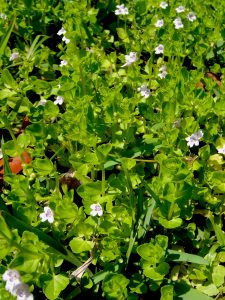
It’s a native little mint with a variety of names. Photo by Green Deane
One little plant that is everywhere and no where is St. John’s Mint aka Brown’s Savory and to the Internet aquarium trade “Creeping Charlie.” It is difficult to find a wet spot in the Deep South without finding Micromeria Brownei. So why isn’t this ubitqutious little mint in Professor Austin’s 900-page tome “Florida Ethnobotany?” There’s no good evidence it’s a native to Florida. It might be a Caribbean native being found in Cuba and Jamaica. That said the Florida Native Plant Society includes it on its pages. Native or not it is a mint and if it looks like a mint and smells like a mint it can be used like a mint. The low-growning herb is found most often with your feet first, crushing leaves which sends up a strong mint odor that the nose detects easily. Use it if you use mint, avoid it if you avoid mint. To read about the mighty mint go here.
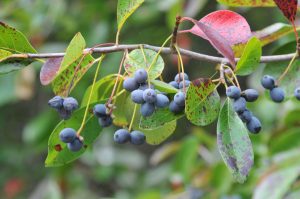
Black Gum Fruit is extremely bitter.
Do you know why the Sweet Gum tree is called that? Because while it tastes mighty bad it is not as bad as the other “gum” trees, one of which is not in season yet but is fruiting, the Black Gum. You have to like sour and bitter to like the Black Gum tree. If you don’t the fruit is offensive and elicits comments that cannot be printed in wholesome publications. This did not stop settlers from adding a lot of sugar to the fruit and making jelly out of it. The seed itself is easy to identify in that under the pulp there are vertical striations covering the seed. We saw a specimen this weekend in Jacksonville. The tree usually looks gangly and has branches that are often on a 90-degree angle to the trunk. To read more about the Black Gum and its nearly-offensive but edible relatives click here.
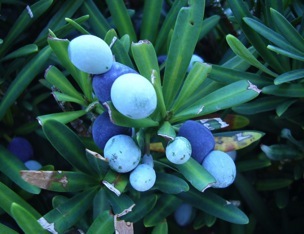 Ripening soon will be Podocarpus arils. The Podocarpus is a very common hedge plant which if ignored will grow into a pine-sized tree. The seeds are mildly toxic (and on the end) but the ripe arils are very grape-like and can be used as grapes, eaten off the bush or made into jelly and wine et cetera. The seeds are listed as toxic but I know of an adult who ate two at one time and had no issue. That said, don’t eat the seeds. When the Podocarpus fruits can be something of a guess. Locally I look for them in August. The fruit can last several weeks and are edible even when they begin to dry and look like raisins. Oddly, in a local park in downtown Winter Park, a few Podocarpus have escaped trimming and have grown into moderate-size trees. I have seen those fruit in December. You can read more about Podocarpus here.
Ripening soon will be Podocarpus arils. The Podocarpus is a very common hedge plant which if ignored will grow into a pine-sized tree. The seeds are mildly toxic (and on the end) but the ripe arils are very grape-like and can be used as grapes, eaten off the bush or made into jelly and wine et cetera. The seeds are listed as toxic but I know of an adult who ate two at one time and had no issue. That said, don’t eat the seeds. When the Podocarpus fruits can be something of a guess. Locally I look for them in August. The fruit can last several weeks and are edible even when they begin to dry and look like raisins. Oddly, in a local park in downtown Winter Park, a few Podocarpus have escaped trimming and have grown into moderate-size trees. I have seen those fruit in December. You can read more about Podocarpus here.
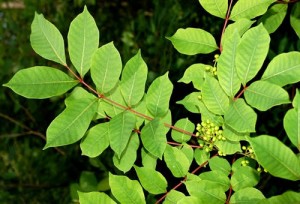 I was teaching a foraging class near a swamp, except the swamp was fairly dry compared to usual years. We came upon a taller than common Saw Palmetto, Seranoa repens. The Saw Palmetto usually grovels, grows low to the ground. I imagine this one was growing up to avoid the water that usually floods the place. Covering the Saw Palmetto were two examples of grapes that grow locally. One climbs with a single tendril and the other has a forked tendril. As usual I waded into the brush to point out the differences, after all the ground was dry. That’s when I noticed another bush in the pile, face to botanical face as it were. I knew what it was immediately which was also immediately too late. The inflorescence growing out of the axil told me all I needed to know even though the leaves were not exactly text book perfect: Poison Sumac. Ironically there was no immediate water available in the swamp to wash with so I pulled up some Dog Fennel and washed my hands with their sap. Good but not totally good enough: I got two minor rashes from it… well… one minor and one not so minor. But at least it’s just a reddening and a little swelling. No blisters. Itched a lot. Benadryl gel worked well.
I was teaching a foraging class near a swamp, except the swamp was fairly dry compared to usual years. We came upon a taller than common Saw Palmetto, Seranoa repens. The Saw Palmetto usually grovels, grows low to the ground. I imagine this one was growing up to avoid the water that usually floods the place. Covering the Saw Palmetto were two examples of grapes that grow locally. One climbs with a single tendril and the other has a forked tendril. As usual I waded into the brush to point out the differences, after all the ground was dry. That’s when I noticed another bush in the pile, face to botanical face as it were. I knew what it was immediately which was also immediately too late. The inflorescence growing out of the axil told me all I needed to know even though the leaves were not exactly text book perfect: Poison Sumac. Ironically there was no immediate water available in the swamp to wash with so I pulled up some Dog Fennel and washed my hands with their sap. Good but not totally good enough: I got two minor rashes from it… well… one minor and one not so minor. But at least it’s just a reddening and a little swelling. No blisters. Itched a lot. Benadryl gel worked well.
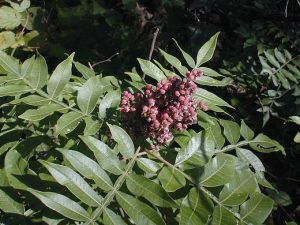
Edible sumacs have terminal clusters of berries.
Sumac you can use can be easily identified from Poison Sumac. Sumac had garnet-colored berries in terminal clusters, meaning on the end of the branches. You usually find the shrub in moderate to dry spots. Poison Sumac has white berries not in terminal clusters but further down the stem closer to the trunk. Poison Sumac is also found in damp spots if not standing water. The Sumac’s terminal clusters should not be harvested right after a heavy rain because the rain washes the acid off and the shrub has to make more. You can also harvest the clusters, hang them up in a dark, dry spot and store them for a season. To read more about the Sumac go here.
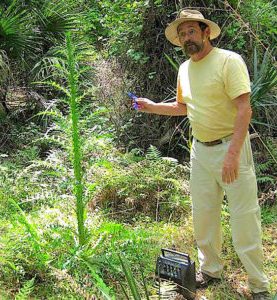
Foraging classes are held rain or shine, heat or cold.
Foraging Classes: These classes almost always happen as schedule. Sometimes a hurricane interrupts those plans or a holiday reduces attendance to zero. Always check back to make sure the class will go on.
Sunday June 24th, John Chestnut County Park: 2200 East Lake Road, Palm Harbor, FL 34685. Meet at the trail head of the Peggy Park Nature Walk, pavilion #1 parking lot. 9 a.m.
Saturday, June 30th, George LeStrange Preserve, 4911 Ralls Road, Fort Pierce, FL, 34981. 9 a.m.
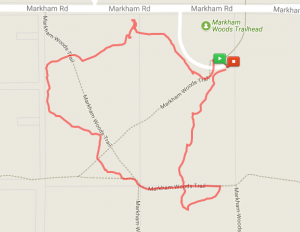
The mushroom hunt area is crisscrossed with wood roads and bike trails.
Sunday July 1st: A non-Green Deane Event. The Orlando Mushroom Group will have its July mushroom hunt with Joshua Buchanan, 9 a.m., at the Markham Trail Head, 8515 Markham Rd, Lake Mary, FL 32746. Fee: $10 per adult. Rain or shine (except hurricanes.) Dress for walking, mosquitoes and ticks. This upland wooded area of oaks and pines reliably produces Chanterelles, various Boletes, Lactifluus, Puff Balls, Russulas and non-edible mushrooms such as Amanitas and Hydenellums. For more information go to the Facebook page Orlando Mushroom Group.
Saturday, July 7th, Blanchard Park, 10501 Jay Blanchard Trail, Orlando, FL 32817. 9 a.m. Meet at the pavilion east of the tennis courts near the YMCA.
Sunday, July 8th, Jervey Gantt Recreation Complex, 2390 SE 36th Ave., Ocala, FL, 34471. 9 a.m. Meet at the entrance to the pool, aka Aquatic Fun Center.
Saturday July 14th, Seminole Wekiva Trail, Sanlando Park, 401 West Highland St. Altamonte Springs, Florida 32714. 9 a.m. Meet at the first parking lot on your right after entering.
Sunday July 15th, Eagle Park Lake, 1800 Keene Road, Largo, FL 33771. 9 a.m. Meet at the pavilion near the dog park.
Saturday, July 21st, Bayshore Live Oak Park, Port Charlotte, Fl. 9 a.m. Meet at the parking lot at the intersection of Bayshore Road and Ganyard Street.
Sunday July 22nd, Lake Woodruff National Wildlife Refuge, 2045 Mud Lake Road, DeLeon Springs, FL. 9 a.m. Meet at the parking lot on right after crossing the railroad tracks. It will be a long, and hot class. Bring water. Bathrooms are port-O-lets.
For more information about classes go here.

Green Deane DVD set of 135 videos
All of Green Deane’s videos available for free on You Tube. They do have ads on them so every time you watch a Green Deane video I get a quarter of one cent. Four views, one cent. Not exactly a large money-maker but it helps pays for this newsletter. If you want to see the videos without ads and some in slightly better quality you can order the DVD set. It is nine DVDs with 15 videos on each. Many people want their own copy of the videos or they have a slow service and its easier to order then to watch them on-line. They make a good gift for that forager you know. Individual DVDs can also be ordered. You can order them by clicking on the button on the top right of this page or you can go here.

Green Deane Forum
Want to identify a plant? Looking for a foraging reference? Do you have a UFO, an Unidentified Flowering Object you want identified? On the Green Deane Forum we chat about foraging all year. And it’s not just about warm-weather plants or just North American flora. Many nations around the world share common weeds so there’s a lot to talk about. There’s also more than weeds. The reference section has information for foraging around the world. There are also articles on food preservation, and forgotten skills from making bows to fermenting food. One special section is “From the Frightening Mail Bag” where we learn from people’s mistakes. You can join the forum by clicking on the button in the menu line.
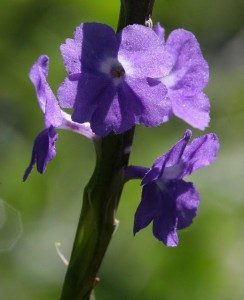
Blue Porterweed, native and imported.
Do you like mushrooms but want to avoid some of dangers that come with fungi foraging? Then there is a subtle solution: Blue Porterweed. Found in flower gardens around the world and native to Florida the Blue Porterweed earned its name as a source for tea that tasted like porter beer. Someone had the fermenting idea to add yeast and sugar to a lot of tea and get a brew that tastes similar to porter beer, hence the name. The flower garden variety usually grows up and the local native grows horizontally. The blue flowers, raw, have a subtle flavor of mushrooms. You can read more about the Blue Porterweed here. Oh, and how did porter beer get its name? The same way porter steak did. Porters — baggage handles in old central London — worked all hours and needed quick food. Shops set up to meet that need and out of them came several dishes and named items.
This is weekly issue 309.
If you would like to donate to Eat The Weeds please click here. Or you can use my Go Fund Me link, or by writing to Green Deane POB 941793 Maitland FL, 32794.

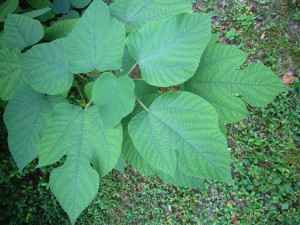

Great job with all you do! When the $&(^ hits the fan, I want to be your neighbor!
Keep up the GOoD work!
Dan